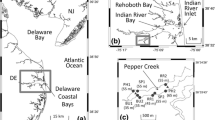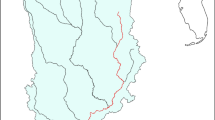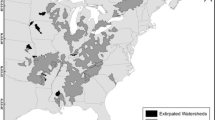Abstract
The mummichog,Fundulus heteroclitus, is one of the most abundant macrofaunal components of salt marsh ecosystems along the east coast of the United States. During April–November 1998, we determined the habitat use and movement patterns of young-of-the-year (YOY) and adult mummichogs in a restored marsh, formerly a salt hay farm, and an adjacent creek in order to expand our understanding of the ecology of the species and evaluate the success of the restoration. Four major fish habitat types (large first-order natural creek, second-order created creek, linear drainage ditch, and marsh surface) were identified within the study site. Patterns of relative abundance and mark and recapture using coded wire tags were used to determine the habitat use, tidal movements, home range, and site fidelity of the species within these habitat types. A total of 14,784 fish, ranging from 20–100 mm SL, were captured with wire mesh traps and tagged, and 1,521 (10.3%) fish were recaptured. A variety of gears were used to attempt to recapture fish across all habitat types, including wire mesh traps, push nets, and otter trawls. Based on abundance and recaptures of tagged fish, the YOY and adults primarily used the shallow subtidal and intertidal areas of the created creek, the intertidal drainage ditches, and the marsh surface of the restored marsh but not the larger, first-order natural creek. At low tide, large numbers were found in the subtidal areas of the created creek; these then moved onto the marsh surface on the flooding tide. Elevation, and thus hydroperiod, appeared to influence the microscale use of the marsh surface. We estimated the home range of adults and large YOY (20–100 mm SL) to be 15 ha at high tide, which was much larger than previously quantified. There was strong site fidelity to the created creek at low tide. The habitat use and movement patterns of the mummichog appeared similar to that reported for natural marshes. Coupled with the results of other studies on the feeding, growth, and production of this species in this restoreh, the species appeared to have responded well to the restoration.
Similar content being viewed by others
Literature Cited
Able, K. W. 1999. Measures of juvenile fish habitat quality: Examples from a National Estuarine Research Reserve, p. 134–147.In L. R. Benaka (ed.) Fish Habitat: Essential Fish Habitat and Rehabilitation. American fisheries society, Symposium 22, Bethesda, Maryland.
Able, K. W. andM. P. Fahay. 1998. The First Year in the Life of Estuarine Fishes in the Middle Atlantic Bight. Rutgers University Press, New Brunswick, New Jersey.
Able, K. W. andS. M. Hagan. 2000. Effects of common reed (Phragmites australis) invasion on marsh surface macrofauna: Response of fishes and decapod crustaceans.Estuaries 23:633–646.
Able, K. W. andS. M. Hagan. 2003. The impact of common reed,Phragmites australis, on essential fish habitat: Influence on reproduction, embryological development and larval abundance of mummichog (Fundulus heteroclitus)Estuaries 26:40–50.
Able, K. W. andD. Hata. 1984. Reproductive behavior in theFundulus heteroclitus-F, grandis complex.Copeia 1984:820–825.
Able, K. W., D. M. Nemerson, P. R. Light, andR. O. Bush. 2000. Initial response of fishes to marsh restoration at a former salt hay farm bordering Delaware Bay, p. 749–773.In M. P. Weinstein and D. A. Kreeger (eds.), Concepts and Controversies in Tidal Marsh Ecology. Kluwer Academic Publishers, Dordrecht, The Netherlands.
Bozeman, Jr.,E. L. andJ. M. Dean. 1980. The abundance of estuarine larval and juvenile fish in a South Carolina intertidal creek.Estuaries 3:89–97.
Butner, A. andB. H. Brattstrom. 1960. Local movements inMenidia andFundulus.Copeia 1960:139–141.
Chitty, J. D. 1999. Movements and growth of the sheepshead minnow,Cyprinodon variegatus, in a restored salt marsh. Master's Thesis, Rutgers University, New Brunswick, New Jersey.
Deegan, L. A. 1993. Nutrient and energy transport between estuaries and coastal marine ecosystems by fish migration.Canadian Journal of Fisheries and Aquatic Sciences 50:74–79.
Halpin, P. M. 1997. Habitat use patterns of the mummichog,Fundulus heteroclitus, in New England. I. Intramarsh variation.Estuaries 20:618–625.
Kneib, R. T. 1986. The role ofFundulus heteroclitus in salt marsh trophic dynamics.American Zoologist 26:259–269.
Kneib, R. T. 1997. The role of tidal marshes in the ecology of estuarine nekton.Oceanography and Marine Biology: An Annual Review 35:163–220.
Kneib, R. T. andA. H. Craig. 2001. Efficacy of minnow traps for sampling mummichogs in tidal marshes.Estuaries 24:884–893.
Kneib, R. T. andS. L. Wagner. 1994. Nekton use of vegetated marsh habitats at different stages of tidal inundation.Marine Ecology Progress Series 106:227–238.
Lotrich, V. A. 1975. Summer home range and movements ofFundulus heteroclitus (Pisces: Cyprinodontidae) in a tidal creek.Ecology 56:191–198.
Mattson, M. T., B. R. Friedman, D. J. Dunning, andQ. E. Ross. 1990. Magnetic tag detection efficiency for Hudson River striped bass.American Fisheries Society Symposium 7:267–271.
McIvor, C. C. andW. E. Odum. 1988. Food, predation risk, and microhabitat selection in a marsh fish assemblage.Ecology 69: 1341–1351.
Nemerson, D. M. 2001. Trophic dynamics and habitat ecology of the dominant fish of Delaware Bay (USA) marsh creeks. Ph.D. Dissertation, Rutgers University, New Brunswick, New Jersey.
Nixon, S. W. andC. A. Oviatt. 1973. Ecology of a New England salt marsh.Ecological Monographs 43:463–498.
Public Service Electric & Gas Co. 1999a. Public Service Electric and Gas Company Detrital Production Monitoring. Publication 99030. PSE&G Estuary Enhancement Program, Newark, New Jersey.
Public Service Electric & Gas Co. 1999b. Public Service Electric and Gas Permit Renewal Application NJPDES Permit No. NJ0005622. Exhibit. G-3-9. March 4, 1999. PSE&G Estuary Enhancement Program, Newark, New Jersey.
Pyke, G. H. 1983. Animal movements: An optimal foraging approach.In I. R. Swingland and P. J. Greenwood (eds.), The Ecology of Animal Movement. Claredon Press, Oxford, U.K.
Roman, C. T., W. A. Niering, andR. S. Warren. 1984. Salt marsh vegetation change in response to tidal restriction.Environmental Management 8:141–150.
Rozas, L. P. 1995. Hydroperiod and its influence on nekton use of the salt marsh: A pulsing ecosystem.Estuaries 18:579–590.
Rozas, L. P., C. C. McIvor, andW. E. Odum. 1988. Intertidal rivulets and creekbanks: Corridors between tidal creeks and marshes.Marine Ecology Progress Series 47:303–307.
Sebold, K. R. 1992. From Marsh to Farm: The Transformation of Coastal New Jersey. New Jersey Coastal Heritage Trail. National Park Service, U.S. Department of the Interior. Washington, D.C..
Smith, K. J. 1995. Processes regulating habitat use by salt marsh nekton in a southern New Jersey estuary. Ph.D. Dissertation, Rutgers University, New Brunswick, New Jersey.
Smith, K. J., G. Taghon, andK. W. Able. 2000. Trophic linkages in marshes: Ontogenetic changes in diet for young-of-the-year mummichog,Fundulus heteroclitus, p. 221–237.In M. P. Weinstein and D. A. Kreeger (eds.), Concepts and Controversies in Tidal Marsh Ecology. Kluwer Academic Publishing, Dordrecht, The Netherlands.
Sokal, R. R. andF. J. Rohlf. 1995. Biometry, 3rd edition. W. H. Freeman, New York.
Talbot, C. W. andK. W. Able. 1984. Composition and distribution of larval fishes in New Jersey high marshes.Estuaries 7:434–443.
Talbot, C. W., K. W. Able, andJ. K. Shisler. 1986. Fish species composition in New Jersey salt marshes: Effects of marsh alterations for mosquito control.Transactions of the American Fisheries Society 115:269–278.
Teal, J. M. 1962. Energy flow in the salt marsh ecosystem of Georgia.Ecology 43:614–624.
Teo, S. L. H. 1999. Movement and population dynamics of the mummichog, Fundulus heteroditus, in a restored salt marsh. Master's Thesis, Rutgers University, New Brunswick, New Jersey.
Teo, S. L. H. andK. W. Able. 2003. Growth and production of mummichogs (Fundulus heteroclitus) in a restored marsh.Estuaries 26:51–63.
Turchin, P. 1998. Quantitative Analysis of Movement: Measuring and Modelling Population Redistribution in Animals and Plants. Sinauer Associates Inc., Sunderland, Massachusetts.
Tupper, M. andK. W. Able. 2000. Movements and food habits of striped bass (Morone saxatilis) in Delaware Bay (USA) salt marshes: Comparison of a restored and a reference marsh.Marine Biology 137:1049–1058.
Unwin, M. J., J. T. Hill, andD. H. Lucas. 1997. An accurate and efficient method for reading sequentially coded wire tags aided by a PC-based data capture program.North American Journal of Fisheries Management 17:446–450.
Valiela, I., J. E. Wright, J. M. Teal, andS. B. Volkmann. 1977. Growth, production and energy transformations in the salt marsh killifishFundulus heteroclitus.Marine Biology 40:135–144.
Weinstein, M. P., J. H. Balletto, J. M. Teal, andD. E. Ludwig. 1997. Success criteria and adaptive management for a largescale wetland restoration project.Wetlands Ecology and Management 4:111–127.
Weisberg, S. B. andV. A. Lotrich. 1982. The importance of an infrequently flooded intertidal marsh surface as an energy source for the mummichogFundulus heteroclitus: An experimental approach.Marine Biology 66:307–310.
Winker, K., J. H. Rappole, andM. A. Ramos. 1995. The use of movement data as an assay of habitat quality.Oecologia 101: 211–216.
Worton, B. J. 1987. A review of models of home range for animal movement.Ecological Modelling 38:277–298.
Zedler, J. B. 1996. Ecological issues in wetland mitigation: An introduction to the forum.Ecological Applications 6:33–37.
Zedler, J. B. 2001. Handbook for Restoring Tidal Wetlands. CRC Press, New York.
Zedler, J. B. andR. Lindig-Cisneros. 2000. Functional equivalency of restored and natural salt marshes, p. 565–582.In M. P. Weinstein and D. A. Kreeger (eds.), Concepts and Controversies in Tidal Marsh Ecology. Kluwer Academic Publishers, Dordrecht, The Netherlands.
Author information
Authors and Affiliations
Corresponding author
Rights and permissions
About this article
Cite this article
Teo, S.L.H., Able, K.W. Habitat use and movement of the mummichog (Fundulus heteroclitus) in a restored salt marsh. Estuaries 26, 720–730 (2003). https://doi.org/10.1007/BF02711983
Received:
Revised:
Accepted:
Issue Date:
DOI: https://doi.org/10.1007/BF02711983




